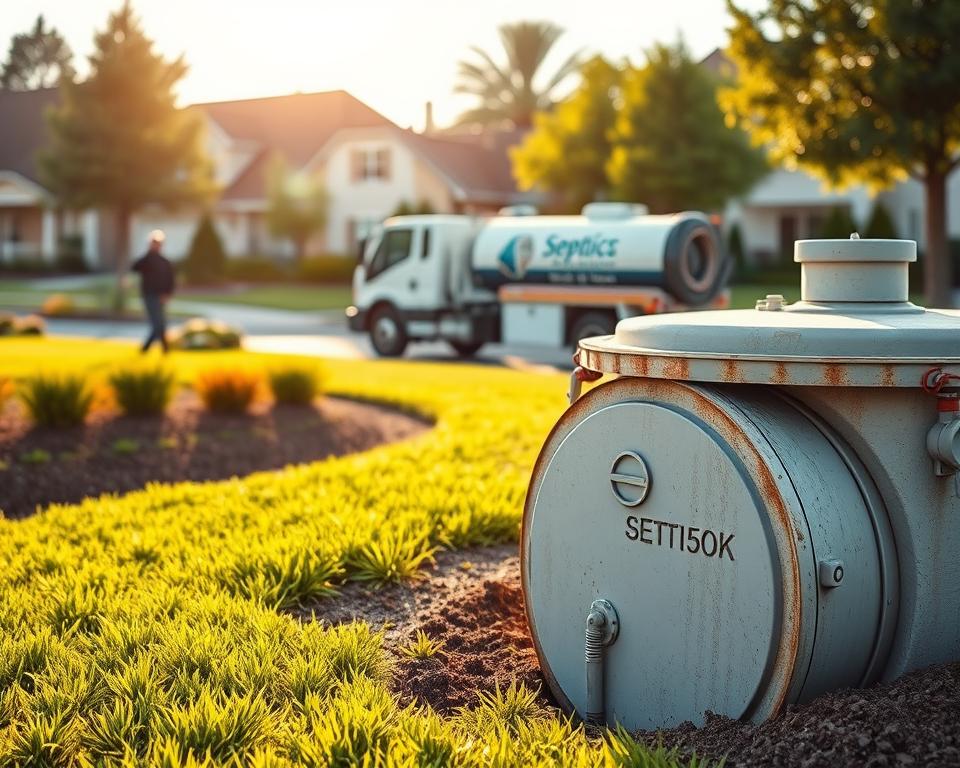Septic System Examination: Safeguard Your Safety
Have you ever pondered the value of your septic system and the hazards of its failure? Nowadays, where proper sewage management is vital, septic system inspections are crucial. They identify issues at an early stage, preventing public-health threats and pricey repairs. Notably in rural locales, homeowners need to make these assessments a priority for property safety and environmental cleanliness.
Fundamental Learnings
- Routine septic system inspections are crucial for heading off costly repairs.
- Septic tank analysis can identify problems promptly, defending public health and ecosystem.
- A qualified septic inspection includes thorough examinations by licensed inspectors.
- Grasping your septic system can improve its longevity and performance.
- Failing to inspect can lead to serious health risks and property damage.
Comprehending the Importance of Septic Systems
Septic systems are crucial for managing household wastewater, particularly where there’s no municipal sewage link. They process on-site wastewater treatment, keeping harmful pollutants at bay. This process is key for environmental safety.
Steady maintenance and checks are essential for septic systems to safeguard community health effectively. A system in good condition prevents wastewater leaks. These leaks can contaminate water sources, placing drinking water and community health at risk.
There’s a direct link between a well-managed septic system and environmental protection. Effective operation of these systems is key to cutting pollution and fostering sustainable lifestyles with septic tank services in my area.
Steps in a Septic System Inspection
The septic system inspection involves key steps to verify its functionality and safety. Experts from All in Sanitation conduct a detailed review, focusing on multiple components of the system. They strive to ensure everything is in top shape.
During the inspection, technicians inspect the septic tank, looking for any leaks or pipe issues. They measure the septic tank’s liquid levels to guarantee efficient performance. This thorough evaluation halts problems from escalating, sidestepping contamination and failure.
Knowing these critical steps enables homeowners to manage their septic systems effectively. By identifying issues early through a proper inspection, the system’s life can be considerably extended. This safeguards against potential risks.
Key Parts Checked in a Septic System Inspection
A full septic system inspection covers vital components to ensure its smooth functioning. The initial focus is on the septic tank, a core element of the system. Inspectors assess the tank’s condition, looking for wear or damage signs. They examine the tank walls, inlet and outlet pipes, and seek any blockages.
Inspectors also assess the drain field, crucial for filtering effluent back into the groundwater. They look for standing water or abnormal vegetation pointing to issues. The distribution box’s flow and distribution are checked to confirm consistency across drain lines.
The septic baffle’s health is another important check. Technicians ensure that the baffles are intact and operate properly, blocking sludge from reaching the drain field. They also measure sludge and scum levels to ensure they are within safe limits.
The inspection’s final step is verifying the system’s watertight integrity. Inspectors check that the tank’s liquid level is normal, stopping any potential leaks or overflows. This detailed verification helps spot minor problems before they become major repairs, thus preserving the septic system’s health.
| Component | Focus of Inspection | Significance |
|---|---|---|
| Septic Tank | State of walls, pipes, and obstructions | Critical for waste collection |
| Drain Field | Standing water, vegetation anomalies | Guarantees proper effluent filtration |
| Distribution Box | Flow and distribution checks | Keeps balanced drainage |
| Baffles | Integrity and function | Prevents sludge migration |
| Liquid Level | Check of normal range | Prevents leaks and contamination |
Typical Problems Detected in a Septic System Inspection
In septic system inspections, experts often spot multiple problems that hurt system efficiency. High on the list are overloaded tanks, usually resulting from too much water use or unnoticed leaks. This condition prevents the system from processing wastewater correctly, resulting in backups and further issues.
Damage or malfunction in pipes is another typical issue found. Such faults block wastewater flow and can lead to costly fixes if left unchecked. Clogged filters also pose significant problems, diminishing system performance and creating environmental risks.
Lack of upkeep aggravates these septic problems. Through regular checks, such issues can be recognized and addressed early. This preventive approach saves homeowners from steep repair costs and safeguards community health.
How Long Does a Septic System Inspection
A typical septic inspection spans from two to 4 hours. Factors like property size and septic complexity affect this duration. Should unexpected problems surface or bad weather restrict access, inspection times may extend. Planning ahead with these timeframes in mind allows homeowners to schedule effectively for a detailed check.
It’s advisable for homeowners to attend the inspection. It gives them to ask questions and hear the inspector’s observations firsthand. Setting this up for a time when full attention can be given improves the experience and final result.
| Factor Affecting Time | Estimated Time (Hours) |
|---|---|
| Basic inspection | 2 – 3 |
| Complex system | 3 – 4 |
| Unforeseen issues | 4+ |
How Often of Septic System Inspections
Consistent septic inspections are vital to maintain your system’s service life and performance. It’s commonly recommended for homeowners to have their septic system inspected every three years. This frequency may be changed depending on factors like the size of your household, the volume of daily water use, and the system’s age.
Bigger households or homes using garbage disposals might need inspections sooner. Keeping up with the right maintenance schedule is vital. It allows catch potential problems early and secures your system operates efficiently.
Here’s a helpful table outlining factors that might affect your inspection frequency:
| Factor | Inspection Cadence |
|---|---|
| Standard Household (2-3 people) | Every 3 years |
| Larger Household (4+ people) | Every 1-2 years |
| Home with Garbage Disposal | Every 1-2 years |
| Older Septic System | Annually |
Adhering to a regular septic maintenance plan offers peace of mind. It forestalls costly repairs and keeps your household safe and sanitary.
Results of Ignoring Regular Septic System Inspections
Not scheduling regular septic inspections increases the risk of system failures. Early-stage issues can grow into larger ones, requiring costly repairs. Wastewater backups from these failures endanger homes and the environment, risking groundwater contamination.
Unaddressed septic issues put people and pets to harmful bacteria and diseases. Homeowners could sidestep hefty expenses with timely inspections. Ignoring routine maintenance can amplify a small problem into a larger crisis, disturbing your daily life and causing stress.
The financial burden of replacing an entire septic system can be daunting. Homeowners bear the full cost. However, consistent inspections enable early problem detection, stopping issues from worsening. Consistent upkeep not only prolongs the system’s life but also rescues homeowners from potential financial and environmental disasters.
Homeowner Tips: Maintaining Your Septic System
For homeowners, septic system care is critical for its longevity and function. Following proper maintenance tips guarantees smooth operation and cuts repair costs. Simple steps can greatly improve septic tank performance.
Reducing water use in the home is important. Minor tweaks like patching leaks and choosing low-flow appliances reduce strain on the system. Households should be mindful of their water consumption.
Proper waste disposal is essential. Do not flush items such as wipes, feminine hygiene items, and grease – they harm the system’s balance. Dispose of such materials properly, using rubbish bins or compost.
Reducing caustic cleaners is also vital. Household cleaners can harm the beneficial bacteria in your septic tank. Select eco-friendly cleaning products to protect this crucial ecosystem.
Frequent inspections on the drain field area are essential for proper functioning. Watch for saturated soil or standing water, signs of possible problems. These issues need quick action.
| Action | Rationale |
|---|---|
| Conserve water | Prevents system overload |
| Properly dispose of waste | Maintains balance of the tank |
| Limit harsh chemicals | Protects beneficial bacteria |
| Inspect drain field | Identifies potential problems early |
Implementing these septic system maintenance strategies will sustain your septic care in check. This secures a functional, enduring system for the future.
Professional Septic Inspection Services
Choosing professional septic inspection services is crucial for homeowners. Companies like All in Sanitation provide detailed septic system evaluations. Their skilled experts make sure no critical issue goes unnoticed.
These professional septic inspectors employ sophisticated methods to find problems. This capability is key for ensuring your septic system’s longevity and your property’s health. They share knowledge on how to keep your system functioning well.
Advantages of Working with a Certified Septic Inspector
Working with a certified septic inspector delivers critical advantages for homeowners. These inspectors have thorough knowledge of local regulations and industry norms. Their expertise guarantees comprehensive, accurate inspections, lowering the risk of missing key issues.
These experts have the skills to spot a larger spectrum of potential issues. Thanks to their advanced training, certified inspectors can recognize subtle signs of deterioration or failure. This ability guarantees problems are tackled early, cutting homeowners significant costs and avoiding severe problems later.
Another significant benefit is the peace of mind they provide to homeowners. Knowing a qualified professional is evaluating their system builds confidence. This assurance about the inspection’s quality adds a layer of security, strengthening the system’s reliability.
In closing, the benefits of hiring a certified expert for septic inspection undeniably surpass any cost involved. These benefits include pinpoint accuracy, early detection of potential problems, and a strong sense of security among homeowners about their septic systems.
In Closing
Consistent septic inspections are essential for homeowners who wish to sidestep hefty repairs. These checks go beyond mere routine. They emphasize the vital importance of maintenance in keeping septic systems functioning smoothly.
Working with certified experts, such as All in Sanitation, allows homeowners to sustain the efficiency of their septic systems. This forward-thinking strategy does more than just protect property value. It also bolsters community well-being and environmental health.
Taking timely measures on septic inspections safeguards your investment. It guarantees your home remains a secure and inviting haven for your loved ones.

